Search Thermo Fisher Scientific
Invitrogen
H2AK5ac Recombinant Superclonal Antibody
This Antibody was verified by Cell treatment to ensure that the antibody binds to the antigen stated.
图: 1 / 6
H2AK5ac Antibody (710830) in ICC/IF
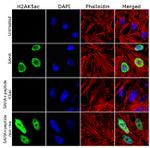
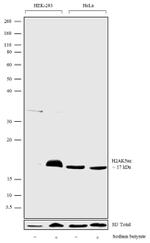
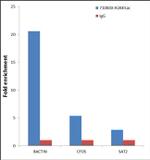
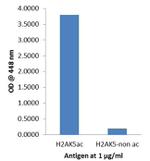
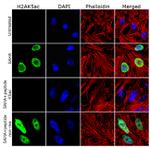
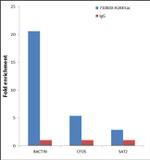
产品信息
710830
种属反应
宿主/亚型
Expression System
分类
类型
抗原
偶联物
形式
浓度
纯化类型
保存液
内含物
保存条件
运输条件
RRID
产品详细信息
This antibody is predicted to react with Rat, Pig, Dog and Cat.
Recombinant rabbit polyclonal antibodies are unique offerings from Thermo Fisher Scientific. They are comprised of a selection of multiple different recombinant monoclonal antibodies, providing the best of both worlds - the sensitivity of polyclonal antibodies with the specificity of monoclonal antibodies - all delivered with the consistency only found in a recombinant antibody. While functionally the same as a polyclonal antibody - recognizing multiple epitope sites on the target and producing higher detection sensitivity for low abundance targets - a recombinant rabbit polyclonal antibody has a known mixture of light and heavy chains. The exact population can be produced in every lot, circumventing the biological variability typically associated with polyclonal antibody production.
靶标信息
Histones are basic nuclear proteins that are responsible for the nucleosome structure of the chromosomal fiber in eukaryotes. Two molecules of each of the four core histones (H2A, H2B, H3, and H4) form an octamer, around which approximately 146 bp of DNA is wrapped in repeating units, called nucleosomes. The linker histone, H1, interacts with linker DNA between nucleosomes and functions in the compaction of chromatin into higher order structures. This gene is intronless and encodes a member of the histone H4 family. Transcripts from this gene lack polyA tails but instead contain a palindromic termination element. This gene is found in the large histone gene cluster on chromosome 6.
仅用于科研。不用于诊断过程。未经明确授权不得转售。
篇参考文献 (0)
生物信息学
蛋白别名: Acetyl-Histone H2; Acetyl-Histone H2A K5; Acetyl-Histone H2A Lys5; H2A 615; H2A GL101; H2A histone family member; H2A histone family, member A; H2A histone family, member C; H2A histone family, member E; H2A histone family, member G; H2A histone family, member M; H2A histone family, member P; H2A histone family, member R; H2A histone family, member X; H2A histone family, member Z; H2A-clustered histone 1; H2A-clustered histone 12; H2A.1; H2A/d; H2a/x; H2A/z; h2ad; H2ae; h2ai; H2ak; H2AK5ac; H2ALys5ac; H2AX histone; H2AZ histone; H2B histone family, member U, (testis-specific); HIS; HIST3H2A; histone 1, H2aa; histone 1, H2ab; histone 1, H2ad; histone 1, H2ae; histone 1, H2ag; histone 1, H2ai; histone 1, H2aj; histone 1, H2ba; Histone H2A type 1; Histone H2A type 1-A; Histone H2A type 1-B/E; Histone H2A type 1-D; Histone H2A type 1-H; Histone H2A type 1-J; Histone H2A.2; Histone H2A.3; Histone H2A.X; Histone H2A.Z; Histone H2A/a; Histone H2A/e; Histone H2A/g; Histone H2A/m; histone H2A/p; Histone H2A/ptl; Histone H2A/r; Histone H2A/s; histone H2AD; histone H2AE; Histone H2AX; Histone H2B type 1-A; Histone H2B, testis; MGC74460; Testis-specific histone H2B; TSH2B.1
基因别名: bA317E16.2; bA317E16.3; dJ160A22.4; dJ86C11.1; H2A.1; H2A.1b; H2A.2; H2A.3; H2A.X; H2A.z; H2A.Z-1; H2A/a; H2A/c; H2A/E; H2A/g; H2A/m; H2A/p; H2A/S; H2A/X; H2A/z; H2AA; H2AC1; H2AC11; H2AC12; H2AC13; H2AC14; H2AC15; H2AC16; H2AC17; H2AC4; H2AC7; H2AC8; H2AFA; H2AFALii; H2AFC; H2AFD; H2AFE; H2AFG; H2AFI; H2AFM; H2AFN; H2AFP; H2AFR; H2AFX; H2AFZ; H2AG; H2AH; H2AX; H2AZ; H2AZ1; H2BC1; H2BFU; HIST1H2AA; HIST1H2AB; HIST1H2AD; HIST1H2AE; HIST1H2AG; HIST1H2AH; HIST1H2AI; HIST1H2AJ; HIST1H2AK; HIST1H2AL; HIST1H2AM; HIST1H2BA; pH2A/f; STBP; TH2A; TH2B; TSH2B; TSH2B.1
UniProt ID: (Human) P16104, (Human) P0C0S5, (Human) Q96QV6, (Human) P04908, (Human) P20671, (Human) P0C0S8, (Human) Q96KK5, (Human) Q99878, (Human) Q96A08
Entrez Gene ID: (Human) 3014, (Human) 3015, (Human) 221613, (Human) 8335, (Human) 3013, (Human) 3012, (Human) 8969, (Human) 85235, (Human) 8329, (Human) 8331, (Human) 255626



